The Case of the Messy Message and the Missing Facts written by Judy Bradbury, illustrated by Gabriella Vagnoli; City of Light, 2022.
In Book 3 of the Cayuga Island Kids chapter book series, the five friends embark on solving mysteries involving faulty assumptions, from missing glitter pens to flour bugs and chocolate chip cookies—and come to realize the importance of getting all the facts instead of just a fraction of the truth before drawing a conclusion.
My goal is to invite readers to think along with me and draw their own conclusions.~ Meghan Daum
Why this Book? Why will it matter to kids?
When a classmate jumps to conclusions and shares false information about Julian’s chocolate chip cookies, the Cayuga Island Kids join forces to set the facts straight. When two of Ms. Choi’s glitter pens go missing, the clues and evidence point to a suspect, but are the Cayuga Island Kids jumping to conclusions? Then, while researching explorers for a school project, the kids uncover misinformation that blurs the truth, and makes the reasons for being a fact detective crystal clear.
Readers encounter science, mystery, research skills, history, teamwork, social-emotional themes, humor, friendship, and even a real chocolate chip cookie recipe as they join the Cayuga Island Kids in sorting through clues and evidence, making sure they have all the facts, and not just a fraction of the truth.
Levels and Layers of Learning
Grade level: 1-4
Social-Emotional Learning Themes
Acceptance, commitment, community, compassion, concern, connection, creativity, curiosity, decision-making skills, dedication, diligence, diversity, effort, empathy, empowerment, encouragement, fortitude, friendship, generosity of spirit, gentleness, gratitude, honesty, hope, interpersonal relationships, inspiration, helpfulness, integrity, kindness, loyalty, patience, perseverance, persistence, perspective, resilience, resourcefulness, respect, self-assurance, self-awareness, self-management, self-reliance, tenacity, trustworthiness, understanding
Content Area Connections: ELA, Social Studies, Science, Community, Math, Arts
Using This Book in the Classroom
Write Away! Ideas to prompt writing
Cayuga Island Park, the setting of The Case of the Messy Message and the Missing Facts, is a favorite location for the Cayuga Island Kids to gather and spend time together. Where do you like to spend time with your friends? Write a description. Be specific and give details. Illustrate and write a caption.
In Chapter 5 “Specks” Julian reflects, Maddie wasn’t the friendliest kid in school. She could be bossy, and she liked things her way. But she wasn’t mean. He didn’t think she would say something just to hurt someone’s feelings. (pg. 35) Do you know someone like Maddie? Write about a time when someone hurt your feelings even though they didn’t mean to, or write about a time when you hurt someone’s feelings because of something you did or said even though you didn’t intend to be mean.
Maddie jumps to conclusions about the specks in Julian’s cookies. Later, the Cayuga Island Kids realize that they jumped to conclusions, too: in the cafeteria, they didn’t eat their cookies because they believed what Maddie said. Write about a time when you jumped to conclusions and later found out that what you assumed was not true.
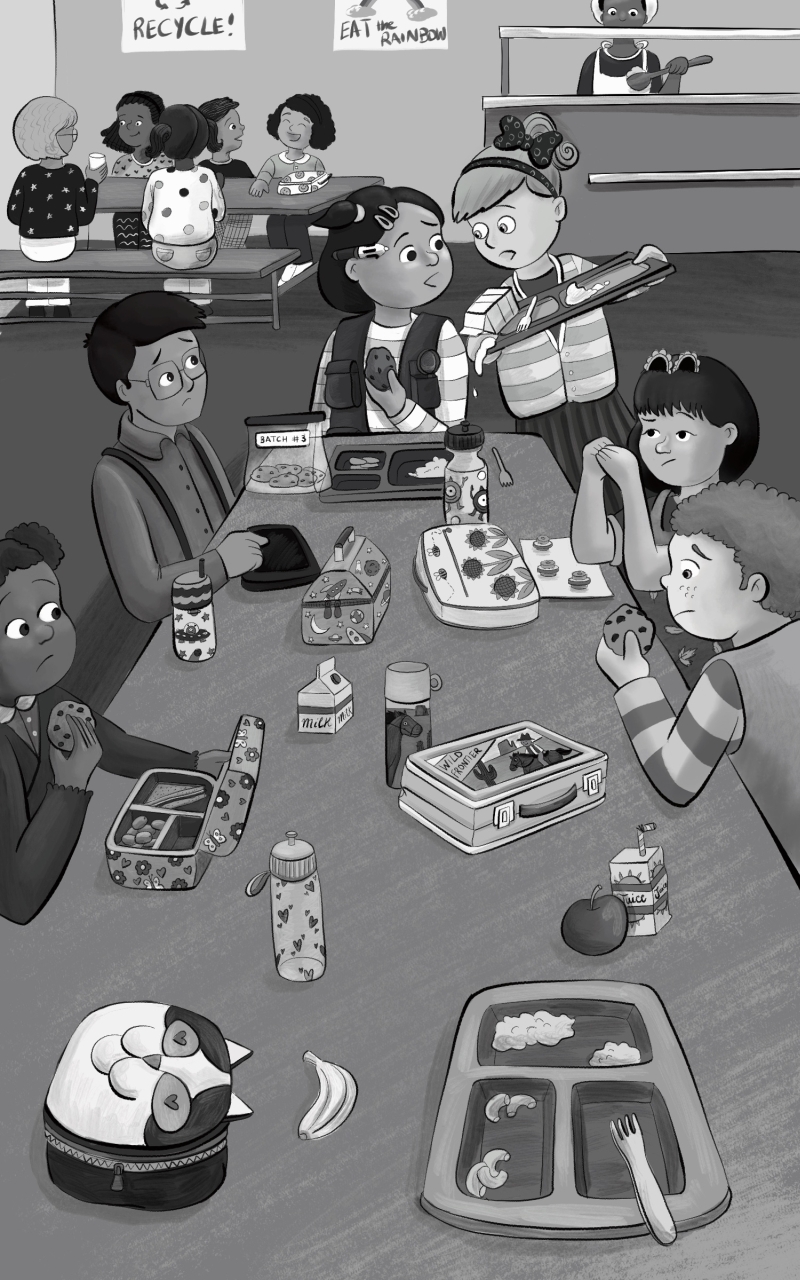
Illustration © Gabriella Vagnoli
In Chapter 12 “Fact Detectives” the Cayuga Island Kids are kind and helpful. They care about Maddie’s feelings just like they care about Julian’s feelings earlier in the story. They explain to Maddie how she jumped to conclusions, but they do so gently and with kindness. Despite the way she behaved, they are considerate of her feelings. Write about a person you know who acts with kindness even when treated unfairly. Be specific and use details. Or, tell about a time when someone treated you unjustly and you forgave them. Or, tell about a time when someone was mean to you and you reacted by being mean to them. How could you have treated that person differently, showing compassion the way the Cayuga Island Kids treated Maddie?
Mac’s math teacher, Ms. Spritski, says, “Math is all around us!” Give 2-3 examples showing that math is all around us.
In Chapter 17 “Important” Lacey says, “We have clues. We have evidence…But maybe we don’t have all the facts.” Write about a time when clues pointed to a conclusion but you realized you didn’t have all the facts.
Poetry Break Related poetry to recite before or following the reading of this book
Poetry breaks fit perfectly into brief moments in the day—from opening or closing the day to lining up for lunch; from zipping up backpacks and jackets to transitioning from one subject to the next. Reading a poem typically takes less than a minute, yet it can introduce or reinforce a concept, provide clarity, celebrate language, exemplify rhythm, enhance vocabulary, expand understanding, increase attention span, initiate reflection, spark imagination, or simply summon a giggle. With an emphasis on rhythm, rhyme, and letter sounds, poetry bolsters reading and writing skills. As if that isn’t enough, poetry also soothes and strengthens the spirit.
As the school year begins in The Case of the Messy Message and the Missing Facts, math equals fractions in Mac and Julian’s class. And though Mac is trying to be friends with math, he decides math is not friendly.
Using the letters that make up the word math, he thinks the math all around him is Mental Agony Torturing Humans.
In an acrostic poem, the first letter of each line spells out a word when read vertically. Mac’s acrostic poem would look like this:
Mental
Agony
Torturing
Humans
Find acrostic poems in these books:
- Catch Your Breath: Writing Poignant Poetry by Laura Purdie Salas; pp. 18-20.
- A Kick in the Head: An Everyday Guide to Poetic Forms selected by Paul B. Janeczko, illustrated by Chris Raschka; pp. 36-37.
- “My Story” pg. 21, Write! Write! Write! by Amy Ludwig VanDerwater, illustrated by Ryan O’Rourke
- Poetry from A to Z: A Guide for Young Writers compiled by Paul B. Janeczko, pp.8-9.
- Silver Seeds: A Book of Nature Poems by Paul Paolilli and Dan Brewer, illustrated by Steve Johnson and Lou Fancher
- “Top Secret” in Book Speak! Poems About Books by Laura Purdie Salas, illustrated by Josée Bisaillon
Find information about acrostic poems, teaching ideas, and acrostic poems by Lewis Carroll and Edgar Allan Poe online. See also Kenn Nesbitt’s Poetry4Kids.
And Then There’s This…
Enrichment activities, related books, online resources, craft projects, and ideas for further study
In The Case of the Messy Message and the Missing Facts, Yoko is practicing facial expressions and gestures in anticipation of the school play tryouts. Gestures and facial expressions, or body language, help us know how others are feeling.
Close read the book to find where Yoko and other characters use gestures and facial expressions (Examples: pp. 14, 16, 35, 39, 50, 61, 63, 71, 72, 76, 82, 98). Study the illustration on page 84. Create a poster illustrating the gestures and facial expressions found in the book (You are encouraged to add others!). Label the feelings associated with them. Display.
Game Time! Provide an opportunity for students to practice the gestures and facial expressions on the poster. Next, place each gesture and facial expression on an index card. Shuffle the cards and place face down. Students take turns choosing an index card and performing the gestures and facial expressions. Classmates guess what feeling is being conveyed. (Think Charades.)
In Chapter 4 “Cookie Research” Julian and his dad are working together to test chocolate chip cookie recipes. Julian knew from reading on the internet that there are variables when baking cookies. Food science. Ingredients and methods make a difference. He clicked to the cookie chart he had saved on his tablet. Flat, crunchy edges and a chewy middle might mean they needed to adjust the amount of baking powder and baking soda. (pg. 30) Delve into food science. Investigate cookie baking variables. Conduct cookie research!
The Case of the Messy Message and the Missing Facts Word Search
The Case of the Messy Message and the Missing Facts downloadable bookmarks
Fraction of the Truth Character Pizza activity
View a collection of Little Free Libraries from Judy’s travels in the FAQ section of the website, and then scroll down to learn more about Little Free Libraries.
Related Books of Interest
Food and food science are woven throughout The Case of the Messy Message and the Missing Facts, from chocolate chip cookies to carrots, to tomato sauce (with shredded carrots), to pizza. Enjoy the following books that link food with math:
-
- Doggone Lemonade Stand! by Judy Bradbury, illustrated by Cathy Trachok
- Eating Fractions by Bruce McMillan
- Eat Your Math Homework: Recipes for Hungry Minds by Ann McCallum, illustrated by Leeza Hernandez
Meet the Author & Illustrator


Judy Bradbury is an award-winning author, literacy advocate and educator, and host of the Children’s Book Corner blog. She is also a Cayuga Island kid. Judy grew up on the island, which is located a few miles upstream from the mighty Niagara Falls. In the summers, she rode the bicycle her father built for her across the island in search of mysteries to solve. Judy welcomes the opportunity to share her books with students and enjoys leading writing workshops. IG: judy_bradbury; Twitter: @JudyBwrites
Although she has always loved to draw, Gabriella Vagnoli became an illustrator via a circuitous route that allowed her to explore many other interests including theater, music, teaching, and languages. Her work in these fields all had a common thread: communication. And this is what she loves best about illustrating children’s books—the opportunity to visually communicate a story in a way that will indelibly imprint it on young minds, just as she still has with her the illustrated stories from her childhood in Italy.
Backstory: Q & A with Judy and Gabriella
Well, this does seem a little strange, but yes, I am interviewing myself. And Gabriella. We had challenges of course, each at our own desks—me writing and Gabriella, illustrating Book 3 in the Cayuga Island Kids series—but also loads of fun as we created the words and pictures for this series. And now that the book is done and on the shelves, it’s satisfying and enjoyable to be able to discuss various aspects of pulling together this third book in the Cayuga Island Kids series.
Judy Bradbury: How did you land on the plot for The Case of the Messy Message and the Missing Facts?
Judy Bradbury: The third adventure for these five friends who live on a residential island was written in the height of the pandemic, at a time when our country—the whole world—was grappling with loads of information coming at us daily about critical, unprecedented current events. Some of the information was factual, some of it was meant to be but later deemed inaccurate, and some of it was untrue or misrepresented information.
Unreliable information—and opinion—parading as fact is not new. It’s something that has always troubled me. So it’s no wonder that eventually it found its way into one of my stories. In preparation for writing this story, I researched misinformation, disinformation, and the intersection of fact and fiction. I enrolled in webinars, read books, and talked to educators and media professionals. The Case of the Messy Message and the Missing Facts is not tied to recent events, but its theme is timely and universal. As I conceived of the plot for this third adventure for my “fact detective” characters, I thought about how I could weave the importance of seeking out accurate information and avoiding the trap of jumping to conclusions into an entertaining story for 7-10 year-olds.
Misinformation. Disinformation. Big words, big notions. But I was convinced that 7-10 year-olds, the audience my chapter books target, could grasp these concepts. And I believe that raising young people’s awareness concerning truth-vs.-half-truths-vs.-fiction is crucial and needs to begin when kids are first engaging with the wider world.
JB: Tell about one hurdle you experienced in the illustrating of the story or provide a memorable (or humorous!) anecdote related to the making of this book.
GV: Well, The Case of the Messy Message and the Missing Facts has taught me quite a lesson! I pride myself on being a good cook, and I have been cooking since I was quite young, as many Italians do. For many years I have had flour in my pantry that would sit there quite a long time and not once in my life had I seen “bugs” in it. Well, shortly after I got the manuscript for this book and was starting work on the illustrations, I found bugs in my flour for the first time! The book taught me the valuable “trick” of freezing the flour when I get it home, and I have been doing that faithfully ever since.
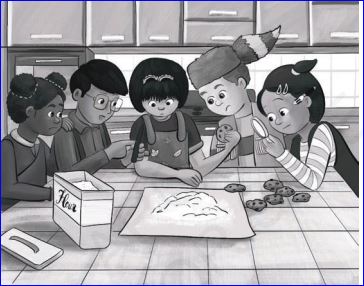
Illustration © Gabriella Vagnoli
JB: Of the three books in the series, The Case of the Messy Message and the Missing Facts was the most challenging to write—not only because I wanted to present a kid-friendly mystery in which the clues point in the wrong direction, yet the resolution is believable—but even more so because I wanted to show young readers through an entertaining story how essential it is to get all the facts—not just bits of information—before drawing a conclusion, or landing on an opinion or belief.
The biggest hurdle was developing the story so that clues and “evidence” pointed in one direction but in fact were faulty. I spent a lot of time working on how the glitter pens came to be missing and where they would end up being found. There were sleepless nights. There was tossing and turning. There were meditation sessions. Once I landed on the resolution, it took my writers’ group’s close reading to point out that what I thought was obvious was not. I was too deep in the weeds: I knew too much! I had to step back. I revised several times until I was sure the plot development was logical. Never did I appreciate my writers’ group and their wise counsel more than I did in the writing of this story.
JB: What would surprise readers to learn about you or about the illustrating of The Case of the Messy Message and the Missing Facts?
GV: I would like people to know that the bus driver in the illustration in Chapter 2 (page 13) was inspired by the wonderful bus driver who has been driving my kids to school for the last few years. You will notice in the illustration that she has curly hair and is wearing heart-shaped glasses, which are my kids’ bus driver’s signature sunglasses when the weather here in the Chicago area is nice enough. Mrs. Dawn is truly a ray of sunshine in the kids’ lives: always cheery, she remembers all of their names and tries to make the ride to school just a little bit special every day. I honestly think all kids deserve a bus driver like Mrs. Dawn. She is a truly special person.
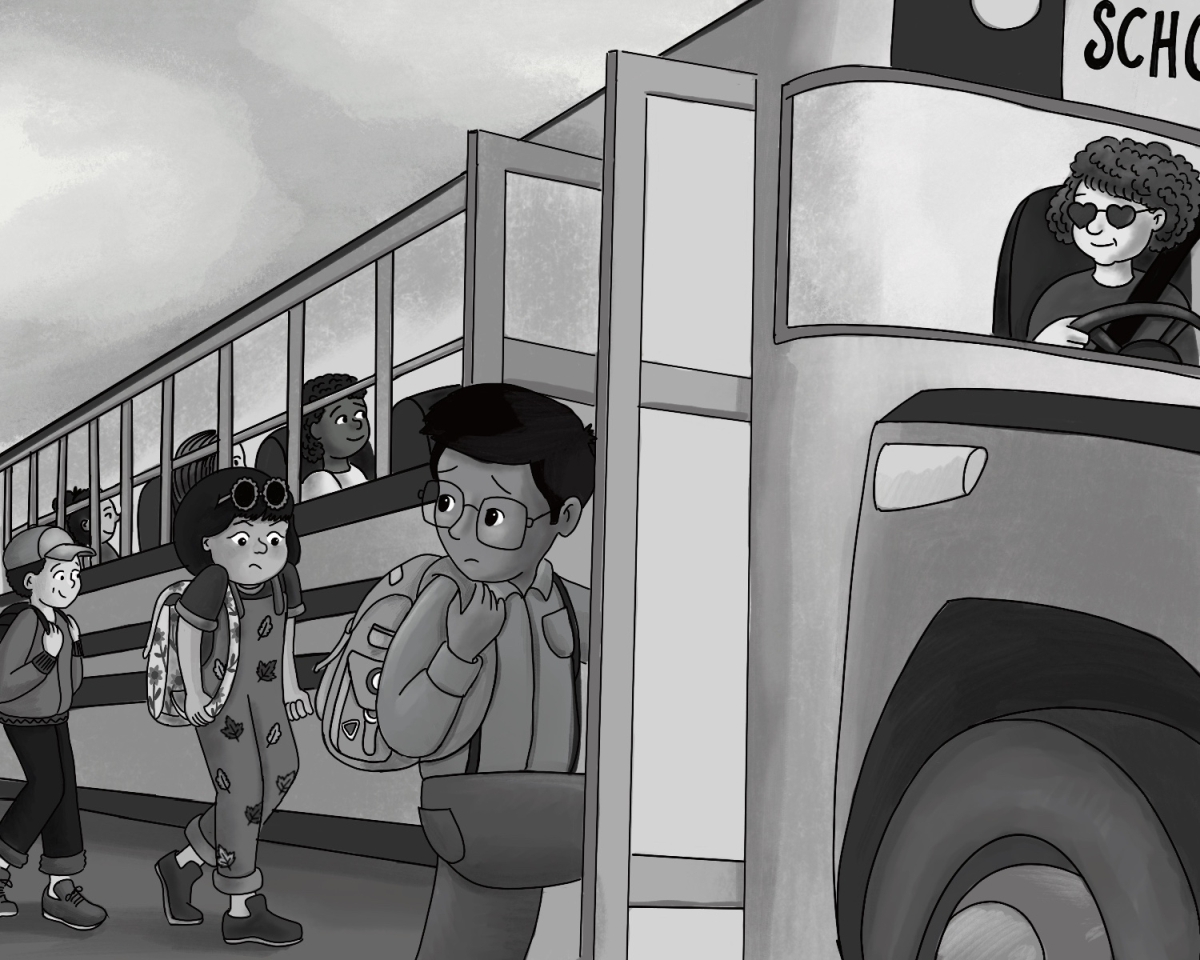
Illustration © Gabriella Vagnoli
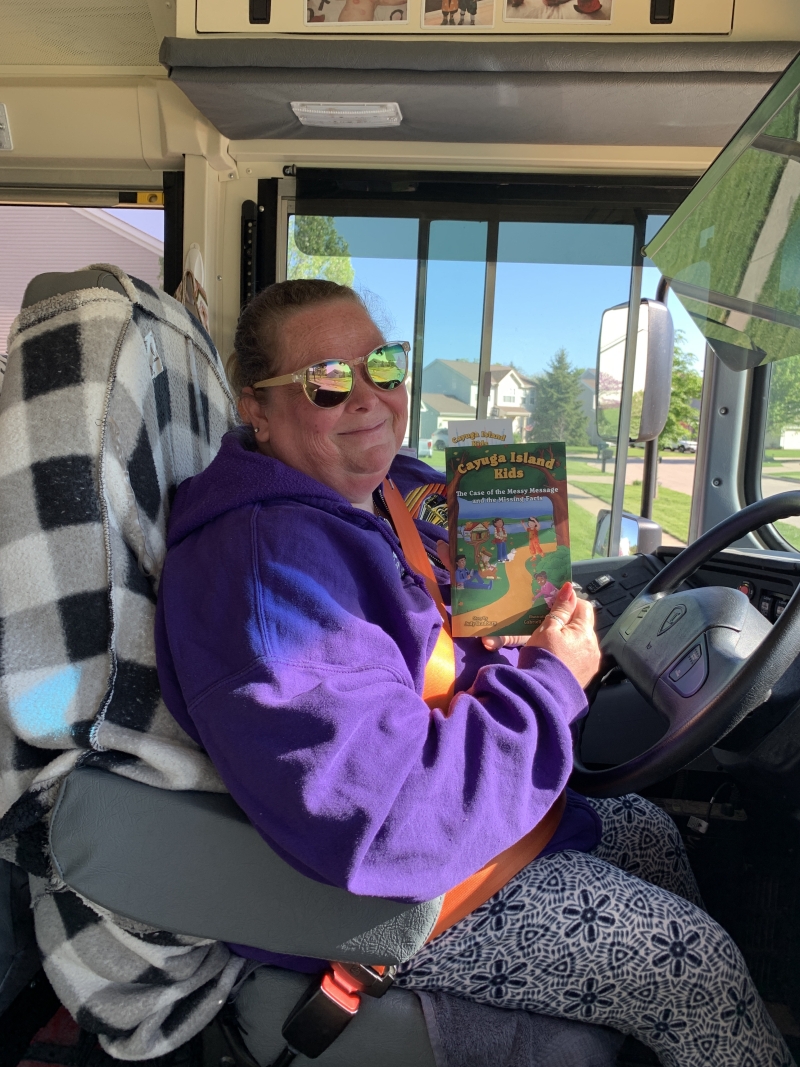
Mrs. Dawn, bus driver; photo by Gabriella Vagnoli
JB: I am a Cayuga Island Kid! Cayuga Island is a real place, a residential island located a few miles upstream from the mighty Niagara Falls in New York State, one of the natural wonders of the world. In the summers, I rode the bicycle my father built for me across the island in search of mysteries to solve. So, though these stories are fiction, there’s a little bit of me and a little bit of memory in each of the Cayuga Island Kids. In the author’s note at the back of the book, I talk about that. And here’s a photo to prove it.
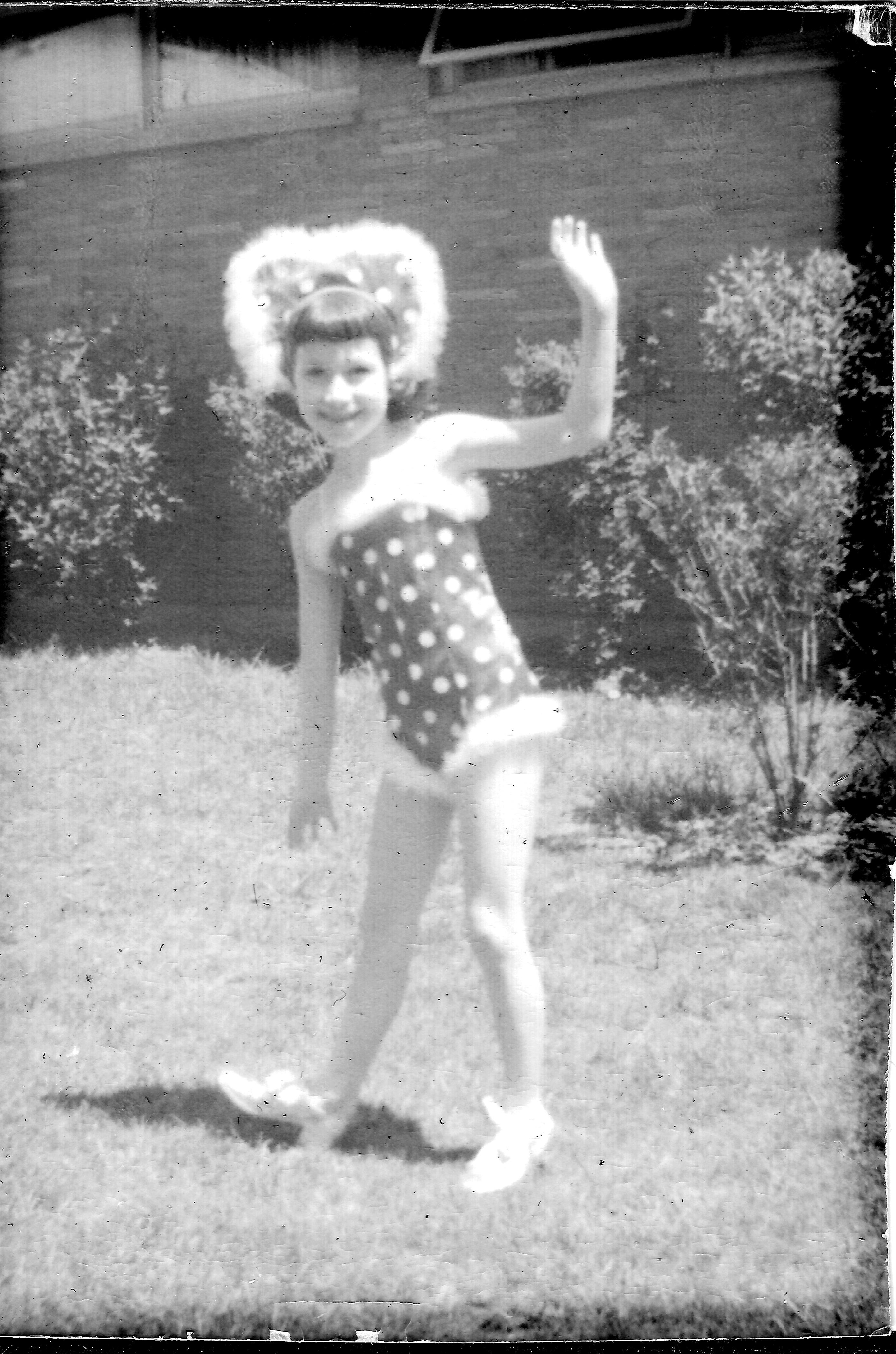
JB: What do you hope young readers and listeners will take away from The Case of the Messy Message and the Missing Facts?
GV: I hope they learn to do their own research before believing (and spreading) any rumor that comes their way; it is definitely an invaluable skill in this day and age.
JB: I agree! The Cayuga Island Kids join forces to solve mysteries: missing glitter pens, flour bugs, wonky websites filled with false information, and fractions! They work together to uncover the truth, rally when the (chocolate) chips are down, and summon their varied interests and strengths to sort out clues. Over the course of events that twist and turn, the kids overcome a number of hurdles to arrive at solutions. In all instances, they face roadblocks and challenges with kindness and compassion, and they stand together as friends. I hope readers internalize that. The Case of the Messy Message and the Missing Facts is ultimately an adventure/mystery story about friendship and kindness. AND, there’s a tasty take away. A real chocolate chip cookie recipe is included at the back of the book. This recipe, by the way, makes the best chocolate chip cookies ever. And that’s the truth!
JB: What can your fans look forward to next? What project(s) are you currently working on?
GV: I am currently working on illustrating a non-fiction picture book about the brain for Blue Manatee Press as well as working on improving my portfolio. Mostly though, I am working on moving my family to the other side of the country: Seattle!
JB: What is one question you wish I had asked, and what is your answer?
GV: Now that you have illustrated three of the books in the Cayuga Island Kids series, do you have a favorite?
And the answer…
Yes, this book is my favorite. Not only did I really enjoy the story and especially the takeaway, but as an illustrator, I believe I have done my best work for this book, so I hope that people will enjoy the illustrations along with the story.
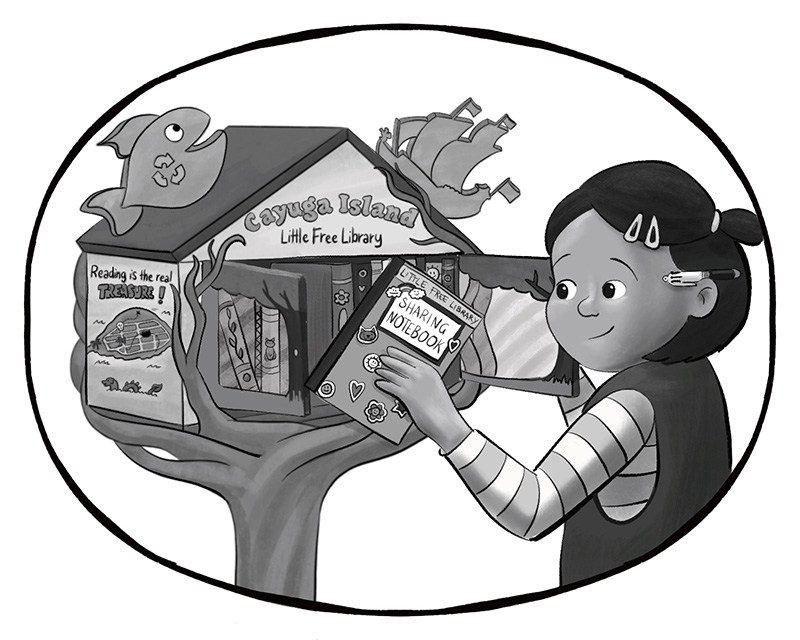
Illustration © Gabriella Vagnoli
Sidebar Spotlight New releases of note
Each month I receive several boxes of books to review from various publishers. As I read and peruse the books, I place them in two piles: those that I will consider featuring on the blog, and those that don’t fit the mission or theme of Children’s Book Corner blog for whatever reason. I highlight some of the books in the “possible” pile on Mondays (most weeks) on Instagram. Ultimately, I have to choose the one new release I will feature on my monthly blog post. Yet there are many terrific books I wish I could give a shout-out to, even if I can’t write an entire post about each one. So, Sidebar Spotlight is a means of giving a nod to new releases that, in my humble opinion, are noteworthy. I’ve linked each title to Bookshop so you can learn more. Happy reading, friends! And feel free to comment below.
-
- A Day For Sandcastles by JonArno Lawson, illustrated by Qin Leng
- Tisha and the Blossoms by Wendy Meddour, illustrated by Daniel Egnéus
- What the Fact? Finding Truth in All the Noise by Dr. Seema Yasmin
- Wondering Around by Meg Fleming, illustrated by Richard Jones
News & Updates
Book 2 in the Cayuga Island Kids series, The Adventure of the Big Fish by the Small Creek, has been awarded the Ben Franklin Silver Award for Young Reader Fiction, 8-12.
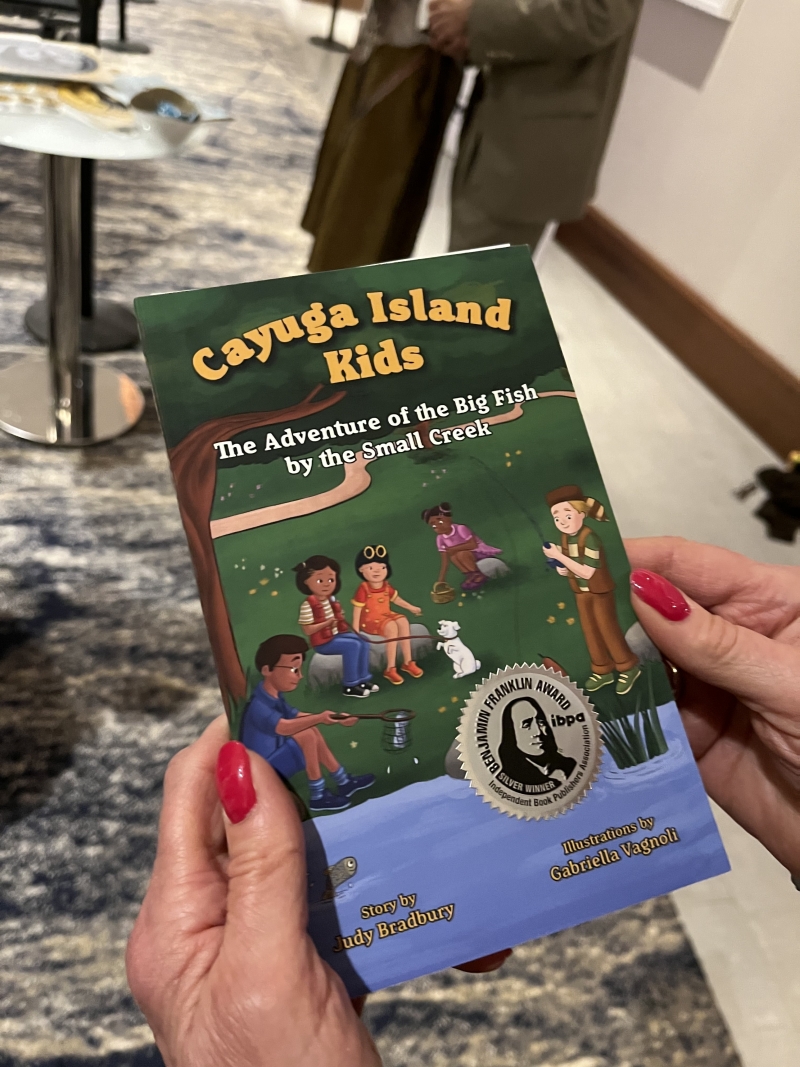
Find additional photos of the event on my website home page.
 If you are attending the ALA annual conference in Washington, DC in June, stop by the IBPA booth! I’ll be there with my publisher, City of Light, signing books and just generally having fun talking with conferees–my peeps!
If you are attending the ALA annual conference in Washington, DC in June, stop by the IBPA booth! I’ll be there with my publisher, City of Light, signing books and just generally having fun talking with conferees–my peeps!
Find news and information on my upcoming events.
Final Thought
“I like to write about questions that interest me, not the conclusions I’ve come to.”~ Rebecca Stead

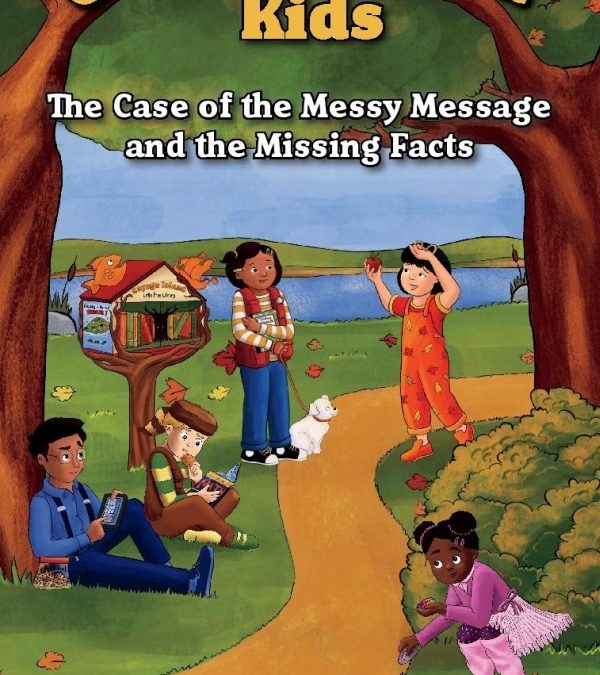
Congratulations on Book 3 of the wonderful Cayuga Kids Series. All three are great fun, but this one addresses the serious concern of how to distinguish fact from opinion and does so in an approachable, sensitive way. Plus I admire how kindness and forgiveness are key as this gentle mystery gets solved. The illustrations just add to the fun of a most worthy story.
Finally, if you didn’t already love the Cayuga Kids, that photo of the original Cayuga Kid in her polka-dotted dance costume will win you over. Talk about a great character!
I always am delighted to find your comments here, Marsha! I appreciate that you like the polka-dotted dance costume. My mother sewed it for me for one of my first tap dance recitals. If I wasn’t tap dancing, I was twirling around the yard in my ballet shoes. I don’t know how she kept me still long enough to fit the costume to me! But she did, and it is a precious childhood memory.
This third Cayuga Island Kids is such a fun book, and this Children’s Book Corner Blog post is one of the best. I love the activities you suggest, and I love all the photos you included–including ready-to-dance-you and the Little Free Library for dogs. Thank you for the FAQ section and sharing about both your early writing (the letter that got you tap dance lessons) and for your daughter’s.
Vivian, it’s always encouraging to read your positive comments and hear about what you appreciated most in a post. It inspires me–especially coming from such an estimable author! Thanks for sharing.